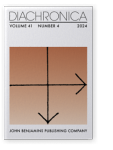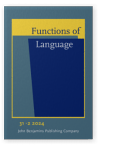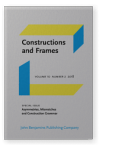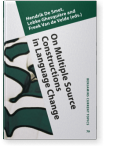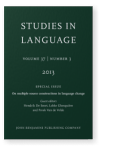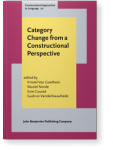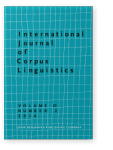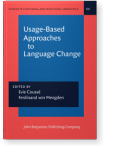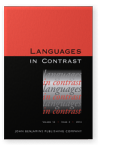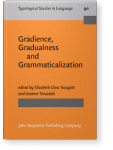Hendrik De Smet
List of John Benjamins publications for which Hendrik De Smet plays a role.
Journals
ISSN 0929-998X | E-ISSN 1569-9765
Explorations in English Historical Syntax
Edited by Hubert Cuyckens, Hendrik De Smet, Liesbet Heyvaert and Charlotte Maekelberghe
[Studies in Language Companion Series, 198] 2018. viii, 312 pp.
Subjects English linguistics | Germanic linguistics | Historical linguistics | Syntax
Asymmetries, Mismatches and Construction Grammar
Edited by Nikos Koutsoukos, Kristel Van Goethem and Hendrik De Smet
Special issue of Constructions and Frames 10:2 (2018) v, 183 pp.
Subjects Cognition and language | Functional linguistics | Syntax | Theoretical linguistics
On Multiple Source Constructions in Language Change
Edited by Hendrik De Smet, Lobke Ghesquière and Freek Van de Velde
[Benjamins Current Topics, 79] 2015. v, 227 pp.
Subjects Functional linguistics | Historical linguistics | Syntax | Theoretical linguistics
On multiple source constructions in language change
Edited by Hendrik De Smet, Lobke Ghesquière and Freek Van de Velde
Special issue of Studies in Language 37:3 (2013) vi, 219 pp.
Subjects Functional linguistics | Theoretical linguistics | Typology
2018 Asymmetries, mismatches and construction grammar: An introduction Asymmetries, Mismatches and Construction Grammar, Koutsoukos, Nikos, Kristel Van Goethem and Hendrik De Smet (eds.), pp. 123–146 | Review article
2018 Chapter 7. The emergence of a new adverbial downtoner: Constructional change and constructionalization of Dutch [ver van X] and [verre van X] ‘far from X’ Category Change from a Constructional Perspective, Van Goethem, Kristel, Muriel Norde, Evie Coussé and Gudrun Vanderbauwhede (eds.), pp. 179–205 | Chapter
The English expression far from, denoting spatial or metaphorical distance, has developed into an adverbial downtoner (De Smet, 2012). In this corpus-based study, our first purpose is to analyze to which degree the Dutch counterparts of the English [far from X] construction, that is [ver van X] and… read more
2016 The root of ruthless: Individual variation as a window on mental representation International Journal of Corpus Linguistics 21:2, pp. 250–271 | Article
Linguistic variation between individuals must be linked to how linguistic material is mentally represented. Therefore, by examining individual variation, light can be shed on the nature of mental representation itself. This paper presents an individual differences study of semi-opaque derivations… read more
2015 Serving two masters: Form–function friction in syntactic amalgams On Multiple Source Constructions in Language Change, De Smet, Hendrik, Lobke Ghesquière and Freek Van de Velde (eds.), pp. 63–94 | Article
This paper examines two cases of so-called syntactic amalgams. In syntactic amalgams a particular string that is shared by two constructions is exploited to combine them, in such a way that one of the constructions functions as a modifier of the other. Typical examples are after God knows how many… read more
2015 On multiple source constructions in language change On Multiple Source Constructions in Language Change, De Smet, Hendrik, Lobke Ghesquière and Freek Van de Velde (eds.), pp. 1–17 | Article
2014 Does innovation need reanalysis? Usage-Based Approaches to Language Change, Coussé, Evie and Ferdinand von Mengden (eds.), pp. 23–48 | Article
Syntactic reanalysis has been claimed to be the only mechanism capable of explaining syntactic change. However, the concept of syntactic reanalysis is flawed. It insufficiently accommodates gradience in synchronic grammar and in language change, and depends too heavily on ambiguity as a cause of… read more
2014 How nouns turn into adjectives: The emergence of new adjectives in French, English and Dutch through debonding processes Languages in Contrast 14:2, pp. 251–277 | Article
This study focuses on French, English and Dutch adjectives that arise through debonding from N+N (and N+A) compounds or compound-like sequences (e.g. the adjectival uses of English ‘key’ and French clé “key”). Debonding is a type of degrammaticalization defined by Norde as “a composite change… read more
2013 Serving two masters: Form–function friction in syntactic amalgams On multiple source constructions in language change, De Smet, Hendrik, Lobke Ghesquière and Freek Van de Velde (eds.), pp. 534–565 | Article
This paper examines two cases of so-called syntactic amalgams. In syntactic amalgams a particular string that is shared by two constructions is exploited to combine them, in such a way that one of the constructions functions as a modifier of the other. Typical examples are after God knows how many… read more
2013 On multiple source constructions in language change On multiple source constructions in language change, De Smet, Hendrik, Lobke Ghesquière and Freek Van de Velde (eds.), pp. 473–489 | Article
2010 Grammatical interference: Subject marker for and the phrasal verb particles out and forth Gradience, Gradualness and Grammaticalization, Traugott, Elizabeth Closs and Graeme Trousdale (eds.), pp. 75–104 | Article
Two instances of grammaticalization are examined that illustrate the gradual character of change and the categorial ambivalence of grammaticalizing items. The first change is the development of the subject marker for in the English for...to-infinitive, whose expansion into new grammatical… read more
